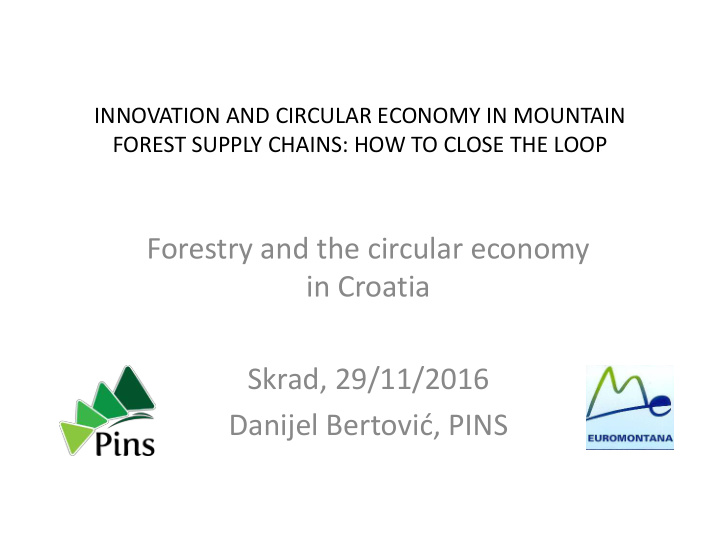



INNOVATION AND CIRCULAR ECONOMY IN MOUNTAIN FOREST SUPPLY CHAINS: HOW TO CLOSE THE LOOP Forestry and the circular economy in Croatia Skrad, 29/11/2016 Danijel Bertović, PINS
Forests in Croatia • Total area of forests and forest land in Croatia amounts to 2.688.687 ha which is 47% of its total land area • 2.106.917 ha (75%) is state-owned • 581 770 ha (25%) are privately owned • vast majority of state-owned forests is managed by state company „ Hrvatske šume” (2, 018.987ha).
GROWING STOCK • growing stock in Croatia amounts to 398 million m 3; • 302 million m 3 stems from the state forests ; • more than 78 million m 3 stems from the privately-owned forests; • 17 million m 3 from the state forests managed by other legal entities;
GROWING STOCK IN CROATIA Growing stock by tree species Fir Hornbeam Oaks Beech http://portal.hrsume.hr/index.php/hr/ume/opcenito/sumeuhrv
ANNUAL INCREMENT AND ANNUAL YIELD • Annual increment in Croatia amounts to 10,5 million m 3 8 milion m 3 stems from the forests managed by Hrvatske • šume 2,1 million m 3 from the privately owned forests • Annual yield in the forests managed by Hrvatske šume amounts averagely 5,8 million m 3
WOOD INDUSTRY • cca 22 000 employees • 3,5% of national GDP • 9% of Croatian exports • very important industry in rural and mountains areas
WOOD INDUSTRY Some weaknesses • Weak joint co-operation , means inadequate vertical and horizontal integration of the wood- ‐ processing industry sector. High intensity of rivalry, especially in the low profitability sub-sectors of the wood processing industry; Inadequate networking between public, private and scientific and research sectors. • Unskilled and untrained employees has been stressed as one of the main problems for the private sector. The main problems are; poor work productivity and high cost of manufacturing; labour market not harmonised with commercial needs (lack of competencies). • Low level of investment in R&D , technology transfer and commercialisation of innovations. This is one of the most important elements in strengthening competitiveness and therefore it should be the area where the main improvements should be expected in the future. • Joint branding and marketing which represent a pillar for develop the internationalization process. • Old technology and low value added of wood-processing sector (poor structure of manufacturing industry – low level of finalisation)
WOOD INDUSTRY Areas of opportunity • furniture design - new product development (accompanied with branding), • the concept of eco-design, • sustainable building concept, • renewable energy sources using wood biomass, • application of wood in bio‐based society, • sustainable forest management, • utilization of KET technologies in the wood‐processing sector.
Some steps towards local circural economy • Villignes of policy makers on local/regional/national level • Networking between public, private and scientific and research sectors even in rural areas (P-IRIS project) • Higher level of processing raw materials in local companies • Creation of new selling model for local raw materials • Development of local logistical/support centers • Permanent education
Thank you for attention
Recommend
More recommend